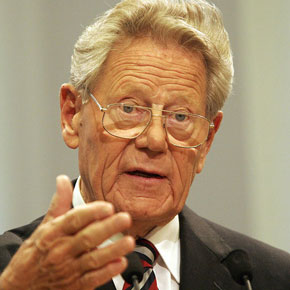Kung Gives Hope to Priests Seeking Reform
By Kevin Hegarty
The recent 50th anniversary of the start of the Second Vatican Council has occasioned a plethora of reminiscences and reflections about the most crucial event in the Catholic Church in the last century. For me, the most interesting contribution has come from the Swiss theologian, Hans Kung. Kung was an adviser at the council along with Joseph Ratzinger, now Pope Benedict XVI. Both were then in their early thirties and regarded as ‘boy theologians’ by their elderly and venerable colleagues. Since then their paths have diverged considerably. Kung has ploughed a lonely furrow as an upholder of the reforms of the council while Pope Benedict, frightened by the student protests of the 1960’s, has become a theological reactionary. When Pope John XXIII was asked what he intended by having a council, he replied by opening a window and saying: “That – to let some fresh air into the Church.” The present incumbent of the papal throne has closed the door. Kung is a creative theologian. As a professor at the University of Tubingen he has written over 30 books, several of which have acquired a readership much greater than is usual for works of theology. Among other matters, he has written critically of the Church’s teaching on celibacy, contraception and papal infallibility. The Vatican Curia disdains liberal creativity. So, not surprisingly, it withdrew Kung’s licence to teach as a Catholic theologian in 1979. The attempt to silence and sideline him failed. Kung has remained at the forefront of debate in the church into the eighties. In a recent article he provided an assessment of the Second Vatican Council. He believes that its greatest achievements are in ecumenism, the development of a vernacular liturgy and in an enhanced status for the Catholic laity. He goes on to argue that further reforms have been stymied by the conservative Vatican Curia who seized control of the council agenda when the bishops left Rome. He wrote prophetically in 1965, after the final session of the council: “The tension between a church that embraces reform and an unwilling Curia can only produce a serious crisis. If, at least over time, the few forces of renewal in Rome do not gain the upper hand (not least through the filling of high positions in the Curia) and if, as they have to some extent suggested, the others seek to restore the pre-conciliar situation, it can only lead to a great crisis of trust. Only the reform of the Curia, in personnel and structures, can help to avert such a crisis. Here too, the renewal of the spirit and the conversion of the heart is most decisive.” Here he echoes the theme of Mary McAleese’s new book where she argues that the concept of collegiality was not developed after the council. He outlines a number of issues that remain outstanding in the Church and require the summoning of a third Vatican Council: • Birth control and personal responsibility. • The regulation of mixed marriage. The validity of the marriage, raising of children. • Priestly celibacy. • Structural and personal reform of the Roman Curia. • Reform of penance. Confession, abstinence and fasting. • Reform of ecclesiastical dress and titles. •Effective engagement of the affected levels of the Church in the appointment of bishops. • Transfer of the elections of the Pope from the College of Cardinals to a synod of bishops, representative of the Church.” In an interview with ‘The Guardian’ on October 5 Kung has been even more forthcoming on the current crisis in Catholicism. He strongly criticised the guidelines governing the choice of bishops: “The rules for choosing bishops are so rigid that as soon as candidates emerge who say, stand up for the pill, or the ordination of women they are struck off the list. The result was a church of ‘yes men’ almost all of whom unquestioningly toe the line. The only way for reform is from the bottom up. The priests and others in positions of responsibility need to stop being so subservient, to organise themselves and say that there are certain things that they will not put up with anymore.” So he praises Catholic priests who have founded movements in Switzerland and Austria, advocating change in the Church. Our own ‘Association of Catholic Priests’, in Ireland, though he does not mention it, follows a similar line. He argues that there is strength in numbers. “I’ve always said that if one priest in a diocese is roused, that counts for nothing. Five will create a stir. Fifty are pretty much invincible. In Austria the figure is well over 300, possibly up to 400 priests; in Switzerland it’s about 150 who have stood up and it will increase.” Archbishop Schanborn tried to stamp out the revolt by threatening to punish the priests involved but had to retreat: “He soon stopped when he realised that so many ordinary people are supportive of them and he was in danger of turning them all against him.” Some hope there for the ‘Association of Catholic Priests’ as it continues its campaign of reform.
|
.
Any original material on these pages is copyright © BishopAccountability.org 2004. Reproduce freely with attribution.
